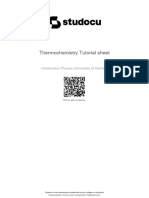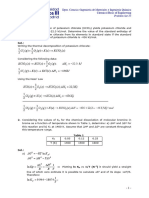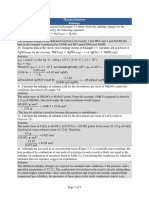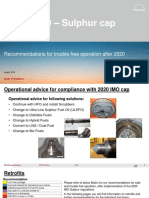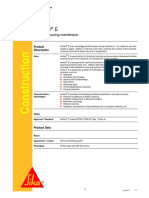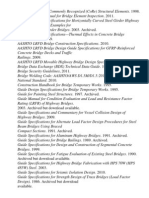Chapter 6 Practice 2017
Chapter 6 Practice 2017
Uploaded by
api-374854456Copyright:
Available Formats
Chapter 6 Practice 2017
Chapter 6 Practice 2017
Uploaded by
api-374854456Original Title
Copyright
Available Formats
Share this document
Did you find this document useful?
Is this content inappropriate?
Copyright:
Available Formats
Chapter 6 Practice 2017
Chapter 6 Practice 2017
Uploaded by
api-374854456Copyright:
Available Formats
Chapter 6 Practice Name ___________________ Period _____
1. Ethanol, C2H5OH, is being promoted as a clean fuel and is used as an additive in many gasoline
mixtures. Calculate the Hrxn for the combustion of ethanol. Hf [C2H5OH(l)] = -277.7 kJ/mol;
Hf [CO2(g)] = -393.5 kJ/mol; Hf [H2O(g)] = -241.8 kJ/mol Answer -1234.7
2. A common laboratory reaction is the neutralization of an acid with a base. When 50.0 mL of
0.500 M HCl at 25.0C is added to 50.0 mL of 0.500 M NaOH at 25.0C in a coffee cup
calorimeter, the temperature of the mixture rises to 28.2C. What is the heat of reaction per
mole of acid? Assume the densities of the reactant solutions are both 1.00 g/mL. Answer -54 Kj
3. When a 4.75 gram sample of CaCl2 dissolves in 110 grams of water in coffee cup calorimeter, the
temperature rises from 22.0C to 29.7C. Calculate the molar heat of solution of CaCl2. Answer -82.80
Kj/mole
4. Ammonium nitrate (NH4NO3, MM= 80.05 g/mol) is a salt used in cold packs to ice injuries. When
20.0 g of this salt dissolves in 125 g of water in a coffee cup calorimeter, the temperature falls
from 23.5C to 13.4C. Determine the q and H for the reaction. Is this process exothermic or
endothermic? Answer 5.28 Kj
5. a) Many metal oxides are smelted with carbon or carbon monoxide to free the metal, which
may need to be condensed to the solid for use. Use the following information to determine the
enthalpy for the production of molten tin from one of its oxides:
SnO2 (s) + 2 C (s) Sn (l) + 2 CO (g) H = ?
Given information:
SnO (s) + CO (g) SnO2 (s) + C (s) H = -189.5 kJ
2 Sn (l) + 2 CO2 (g) 2 SnO (s) + 2 CO (g) H = 460.0 kJ
CO2 (g) + C (s) 2 CO (g) H = 172.5 kJ
b) How many kJ of heat would be required to produce 157 g of molten Sn in the net reaction
above? Answers a) 132Kj b) 175 Kj
6. Nitroglycerin, C3H5(NO3)3(l), detonates to produce a hot gaseous mixture of nitrogen, water,
carbon dioxide, and oxygen. The reaction produces -5725 kJ per mole of nitroglycerin.
Determine the heat of formation of nitroglycerin. You can use your notes or your text to look of
the necessary Hf values. Answer 3940 Kj/mole
7. Using the bond energy chart, determine the H of :
a. 2 CH3OH + 3 O2 2 CO2 + 4 H2O
b. OCl2 + I2 OI2 + Cl2
Bond Energy (kJ/mol) Bond Energy (kJ/mol)
HH 436 CC 347
OH 464 C=C 607
CH 413 CC 839
CO 360 C=O 805
NH 393 O=O 498
O Cl 205 C-F 488
C Cl 330 II 151
OI 201 Cl Cl 243
OC 351 FF 153
NN 945
You might also like
- Lab Report 2 Group1Document7 pagesLab Report 2 Group1azamatNo ratings yet
- NF RT N: (Note: Data W Question 1 Will Be Needed For This Question.)Document3 pagesNF RT N: (Note: Data W Question 1 Will Be Needed For This Question.)mh sepahdarNo ratings yet
- Chang Chemistry - Assessment Chapter 6Document13 pagesChang Chemistry - Assessment Chapter 6haha_le12No ratings yet
- Chemical Energetics QuestionsDocument34 pagesChemical Energetics QuestionsGeorge Choo100% (1)
- Lung Mechanics and Ventilation-Lecture NotesDocument16 pagesLung Mechanics and Ventilation-Lecture NotesCarlos Eduardo LinaresNo ratings yet
- Exercise-Part 2 - 2020Document5 pagesExercise-Part 2 - 2020Nguyễn Nam Anh100% (1)
- Exercise-Part 2 - Nov.2018Document5 pagesExercise-Part 2 - Nov.2018Thắm Nguyễn100% (1)
- Chemistry 1 Exam 3 Fall 2017 Form ADocument5 pagesChemistry 1 Exam 3 Fall 2017 Form AKyle LoughranNo ratings yet
- Latihan Soal Termokimia Part 3Document3 pagesLatihan Soal Termokimia Part 3Dyan SeptyanNo ratings yet
- Tutorial 6 - Thermochemistry Sem 1 2018 19Document2 pagesTutorial 6 - Thermochemistry Sem 1 2018 19Myeisha WilliamsNo ratings yet
- Year 10 Bond Energy Calculations WorksheetDocument4 pagesYear 10 Bond Energy Calculations WorksheetVICKNESWARY MUNIYANNo ratings yet
- Tutorial Chapter 2Document3 pagesTutorial Chapter 2Mohd AsrulNo ratings yet
- Thermo Subjective TestDocument14 pagesThermo Subjective TestGaurav SoniNo ratings yet
- Thermodynamics I Worksheet: 4 (G) 2 (G) 2 (G) 2 (G) RXN 4 (G)Document3 pagesThermodynamics I Worksheet: 4 (G) 2 (G) 2 (G) 2 (G) RXN 4 (G)KELLY HUPPNo ratings yet
- ExamQuestionsTroChapter6 TrimmedDocument5 pagesExamQuestionsTroChapter6 TrimmedAli TarekNo ratings yet
- Chapters 6 and 17 Practice TestDocument12 pagesChapters 6 and 17 Practice TestMr. MEMENo ratings yet
- Example #2: The Complete Combustion of Propane Can Be Represented by The Following EquationDocument5 pagesExample #2: The Complete Combustion of Propane Can Be Represented by The Following EquationIka Khusnul KhNo ratings yet
- Thermochemistry assignmentDocument12 pagesThermochemistry assignmentsachinkhurana010No ratings yet
- Quiz - Thermochem PRACTICE ANSWERSDocument2 pagesQuiz - Thermochem PRACTICE ANSWERSliana.mirlohi4No ratings yet
- Thermochemistry Tutorial SheetDocument3 pagesThermochemistry Tutorial SheetonyealiimeldaNo ratings yet
- Ap Unit6 WorksheetDocument4 pagesAp Unit6 Worksheetburcak gecNo ratings yet
- Review F5Document5 pagesReview F5Uchie Pratiwi Fawwaz dan Faza ChanelNo ratings yet
- Gene Chem ExamDocument2 pagesGene Chem Examhiru mangoNo ratings yet
- Chapter 6 Thermochemistry: StudentDocument28 pagesChapter 6 Thermochemistry: StudentKing Ray TabalbaNo ratings yet
- We On EnergeticsDocument4 pagesWe On Energeticsnaimurfahim0018No ratings yet
- 11HThermoPracticeQsDocument5 pages11HThermoPracticeQsJust BetoNo ratings yet
- Ch. 6 and 17 Practice TestDocument12 pagesCh. 6 and 17 Practice TestShashwat ChakrabortiNo ratings yet
- Chapter 5 Review SolutionDocument7 pagesChapter 5 Review SolutionSFDLSFHIOANo ratings yet
- FUELS & THERMOCHEMISTRY Practice Q'sDocument15 pagesFUELS & THERMOCHEMISTRY Practice Q'sIshu PattanayakNo ratings yet
- Tutorial 1Document2 pagesTutorial 1Raja FarhanaNo ratings yet
- Extra Practice Week 6Document2 pagesExtra Practice Week 6ShawnNo ratings yet
- Thermodynamics 4Document11 pagesThermodynamics 4ShyamanshNo ratings yet
- CHEM012 MACONDAN, JEYMART Module 5 AssignmentDocument7 pagesCHEM012 MACONDAN, JEYMART Module 5 AssignmentJeymart MacondanNo ratings yet
- block test-2 exercises chemistry grade 12Document6 pagesblock test-2 exercises chemistry grade 12FREDERICK RAOUL GUNAWANNo ratings yet
- IB Chemistry HL Unit 4 Topic 15 Review 2014 AnswersDocument8 pagesIB Chemistry HL Unit 4 Topic 15 Review 2014 AnswersTrần Thị Diễm HươngNo ratings yet
- Chapter 9 ThermochemistryDocument6 pagesChapter 9 ThermochemistryMohammad AfifNo ratings yet
- (Chem 16) Long Exam 2 Reviewer ADocument6 pages(Chem 16) Long Exam 2 Reviewer ARoland FrancoNo ratings yet
- Thermo ChemistryDocument15 pagesThermo ChemistrySachin Kumar50% (2)
- Chapter 7 Chemical Energetics ExerciseDocument5 pagesChapter 7 Chemical Energetics ExercisembovingjeftheNo ratings yet
- Topic 4 Exercise 1 - Enthalpy ChangesDocument11 pagesTopic 4 Exercise 1 - Enthalpy ChangesKotori Choi IshikawaNo ratings yet
- Thermochemistry ExerciseDocument2 pagesThermochemistry ExerciseilhamunaNo ratings yet
- CH 4 EnergeticsDocument35 pagesCH 4 Energeticsthat guyNo ratings yet
- Thermochemistry WorkbookDocument36 pagesThermochemistry Workbookagrimsinghal28No ratings yet
- ThermodynamicsDocument15 pagesThermodynamicsRaju SinghNo ratings yet
- Tutorial Chemical Energetics Part I SolutionsDocument20 pagesTutorial Chemical Energetics Part I SolutionsDarren LimNo ratings yet
- 5 6159233249949255946 PDFDocument5 pages5 6159233249949255946 PDFardini azmirNo ratings yet
- Chemistry Problem Set 2Document3 pagesChemistry Problem Set 2Maurine KimNo ratings yet
- CH +5+reviewDocument3 pagesCH +5+reviewAarvi ShahNo ratings yet
- Ap Unit6 Worksheet AnswersDocument5 pagesAp Unit6 Worksheet Answersburcak gecNo ratings yet
- PS7 Thermochemistry ThermodynamicsDocument5 pagesPS7 Thermochemistry ThermodynamicsAlyssaNo ratings yet
- TUTORIAL CHAPTER 1 by DR - KavirajaaDocument4 pagesTUTORIAL CHAPTER 1 by DR - Kavirajaaathirah ashikinNo ratings yet
- Invalid HTTP Request HeaderDocument11 pagesInvalid HTTP Request HeaderReeja MathewNo ratings yet
- DocumentDocument3 pagesDocumentAfthirah AmiraNo ratings yet
- Exercises-Topic 5Document5 pagesExercises-Topic 5Arturo AtienzaNo ratings yet
- Thermichemreview QuestionsDocument6 pagesThermichemreview QuestionsSImiSaysRawrNo ratings yet
- Thermochemistry EnthalpyDocument5 pagesThermochemistry Enthalpyjavohirnematjonov932No ratings yet
- AP Thermochemistry Problems 2020Document8 pagesAP Thermochemistry Problems 2020linaNo ratings yet
- Energetics Practice H2 ChemistryDocument2 pagesEnergetics Practice H2 Chemistryjina91100% (1)
- GASEOUS STATE-03-Assignments (New)Document20 pagesGASEOUS STATE-03-Assignments (New)Raju SinghNo ratings yet
- Chem XI (Thermo)Document5 pagesChem XI (Thermo)Lumyy PillenaNo ratings yet
- Periodic TableDocument125 pagesPeriodic TablechristabelNo ratings yet
- Practice Makes Perfect in Chemistry: Oxidation-ReductionFrom EverandPractice Makes Perfect in Chemistry: Oxidation-ReductionRating: 5 out of 5 stars5/5 (1)
- Shop 160Document26 pagesShop 160Jasmin AhmedNo ratings yet
- Aug 2018 MAN Fuel 2020 GuidelineDocument20 pagesAug 2018 MAN Fuel 2020 Guidelineprashantscribd123No ratings yet
- Articulo 2Document9 pagesArticulo 2SofiaNo ratings yet
- Chemical Exposure IndexDocument23 pagesChemical Exposure IndexwankartikaNo ratings yet
- MNS12 OpticalLitho I PDFDocument100 pagesMNS12 OpticalLitho I PDFRahul ReddyNo ratings yet
- Classical Mechanics With MATLAB Applications Javier E - HasbunDocument5 pagesClassical Mechanics With MATLAB Applications Javier E - HasbunAdam A. KhanNo ratings yet
- 2.PFD & PQCS-18293-KVT-9000Document3 pages2.PFD & PQCS-18293-KVT-9000RS MANIKANDANNo ratings yet
- Koya University Faculty of Engineering Chemical Engineering DepartmentDocument17 pagesKoya University Faculty of Engineering Chemical Engineering Departmentwhah11No ratings yet
- Compressibility Factor: RT B V V A PDocument4 pagesCompressibility Factor: RT B V V A PAbid Al Chem NugamaNo ratings yet
- Unit 7: Equilibrium: Introduction To Equilibrium and Reversible ReactionsDocument5 pagesUnit 7: Equilibrium: Introduction To Equilibrium and Reversible ReactionsRylee LippenholzNo ratings yet
- Ccic Test ReportDocument3 pagesCcic Test ReportzoyaNo ratings yet
- Quarter 3 - Module 1C: Nature of CrystalsDocument24 pagesQuarter 3 - Module 1C: Nature of CrystalsJunelle Ramos Aquino100% (1)
- Origanum Vulgare Mediated Biosynthesis of Silver Nanoparticles For ItsDocument5 pagesOriganum Vulgare Mediated Biosynthesis of Silver Nanoparticles For ItsBira AdrianaNo ratings yet
- Antisol E: Concrete Curing MembraneDocument2 pagesAntisol E: Concrete Curing Membranescriptd_ozd3nNo ratings yet
- Subulata Growth Supports Water Supply: The By-Product of Oil Palm Dosage Application On TurneraDocument9 pagesSubulata Growth Supports Water Supply: The By-Product of Oil Palm Dosage Application On TurneraparthibanptrafficNo ratings yet
- Vol 42 - 2 0003 PDFDocument134 pagesVol 42 - 2 0003 PDFchokvuisoonNo ratings yet
- GalvInfoNote 1 2Document4 pagesGalvInfoNote 1 2JdjoNo ratings yet
- 1M32Document11 pages1M32Neill TeodoroNo ratings yet
- Pulse DC Electrodeposition of Zn-Ni-Co CoatingsDocument5 pagesPulse DC Electrodeposition of Zn-Ni-Co CoatingsSorin SorinNo ratings yet
- Ferracane PDFDocument10 pagesFerracane PDFCarlos VazquezNo ratings yet
- Free Body Diagram Work Book StudentDocument15 pagesFree Body Diagram Work Book StudentwshhytNo ratings yet
- OCENCO EEBD SolasInstructionManualDocument14 pagesOCENCO EEBD SolasInstructionManualmitsosmitsosNo ratings yet
- MSDS Asam NitratDocument4 pagesMSDS Asam NitratTyoNo ratings yet
- Density Functionals For Couiomb Systems: Departments New Jersey 08544, U.S.ADocument35 pagesDensity Functionals For Couiomb Systems: Departments New Jersey 08544, U.S.ARamon FerreiraNo ratings yet
- Practical Guide For PHD Candidates at Epfl: Version: August 12, 2008Document91 pagesPractical Guide For PHD Candidates at Epfl: Version: August 12, 2008rjohn1No ratings yet
- Lab Report #1Document10 pagesLab Report #1Vincent Job DeleonNo ratings yet
- ChE 152 Lecture 2a Vapor-Liquid EquilibriaDocument33 pagesChE 152 Lecture 2a Vapor-Liquid EquilibriaEmrico Luiz PerezNo ratings yet
- AASHTO Guide For Commonly RecognizedDocument3 pagesAASHTO Guide For Commonly RecognizedMedhat HasanainNo ratings yet



















